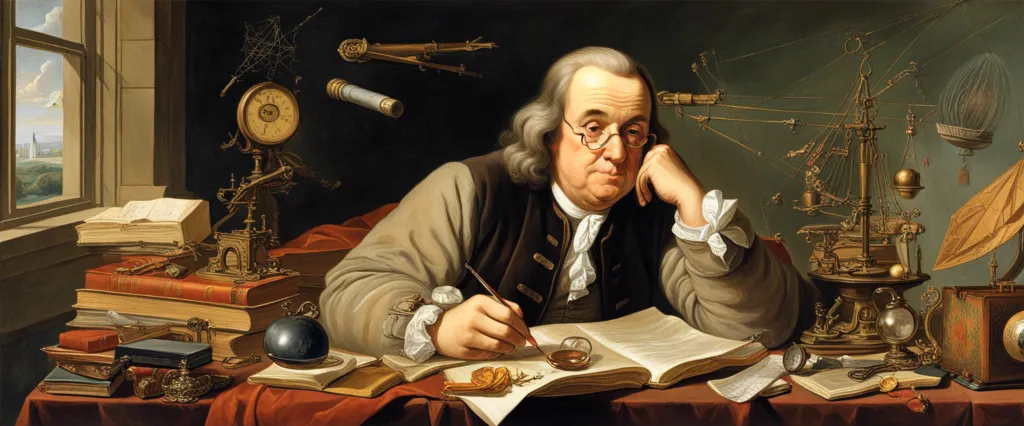——Benjamin Franklin by Walter Isaacson & The Agony And The Ecstasy by Irving Stone

In the vast realm of literature, biographies have always stood as powerful windows into the lives of influential figures. These narratives transport readers through time, offering glimpses into the triumphs, struggles, and complexities of individuals who have significantly impacted the world. Two such remarkable biographies, Benjamin Franklin by Walter Isaacson and “The Agony And The Ecstasy” by Irving Stone, exemplify the power of this genre. While Isaacson meticulously dissects the life of one of America’s founding fathers, Stone delves into the incredible artistic journey of Michelangelo. Although these two biographical works explore different realms of human achievement, they invite readers to explore the psychological landscapes, creative endeavors, and societal contexts that shaped these iconic figures. Through the parallel exploration of Franklin and Michelangelo, these books ultimately aim to unravel the enigmatic essence of greatness.
Brief Summary of Two Books
Benjamin Franklin by Walter Isaacson
Benjamin Franklin” by Walter Isaacson is a comprehensive biography of one of America’s founding fathers and most accomplished individuals. Isaacson explores Franklin’s remarkable life, from his humble beginnings as a printer’s apprentice in Boston to his significant contributions as a scientist, inventor, diplomat, and political leader.
The book delves into Franklin’s insatiable curiosity and thirst for knowledge, documenting his numerous inventions and experiments that propelled him to become one of the foremost scientists of his time. Isaacson explores Franklin’s discoveries in electricity, his role in creating practical devices like the lightning rod, and his experiments that paved the way for modern technologies.
Franklin’s diplomatic accomplishments are also detailed, including his significant role in negotiating the Treaty of Paris, which ended the American Revolution. The book examines Franklin’s diplomatic missions to Britain and France, showcasing his diplomatic finesse and strategic thinking.
In addition to his scientific and diplomatic pursuits, Isaacson delves into Franklin’s role in shaping American society and government. The book explores his involvement in drafting the Declaration of Independence and the United States Constitution, highlighting his belief in democracy, individual freedoms, and equal rights.
Furthermore, the biography delves into Franklin’s personal life and relationships, showcasing his unconventional character traits and extramarital affairs. Isaacson paints a vivid portrait of Franklin’s charm, wit, and ambition, presenting both his lovable qualities and his flaws.
Overall, “Benjamin Franklin” offers a captivating and detailed account of the life and accomplishments of one of America’s most influential figures, shedding light on the multifaceted persona of Benjamin Franklin and his immense contributions to science, diplomacy, and the birth of the United States.
The Agony And The Ecstasy by Irving Stone
The Agony and the Ecstasy” is a biographical novel by Irving Stone that chronicles the life of the renowned Italian artist, Michelangelo Buonarroti. Set against the backdrop of the Italian Renaissance, the book follows Michelangelo’s journey from his early years as an apprentice in Ghirlandaio’s workshop to his later years as a master sculptor and painter. Through vivid descriptions and meticulous research, Stone brings to life the struggles, triumphs, and inner turmoil of this artistic genius.
The novel delves into Michelangelo’s complex relationship with his family, particularly with his overbearing father, who disapproved of his artistic ambitions. It explores his time in the Medici court, where he encounters the influential figures of his time, including Lorenzo de’ Medici and Pope Julius II, both of whom commissioned him for notable works. The book also delves into Michelangelo’s tumultuous relationships with fellow artists and patrons, exposing the political and social dynamics of Renaissance Italy.
Stone highlights the incredible dedication and determination that Michelangelo possessed, often referring to his art as an “agony and an ecstasy.” The book provides a detailed account of Michelangelo’s creation of some of his most renowned works, such as the Sistine Chapel ceiling and the sculpture of David, capturing the artist’s relentless pursuit of perfection, his creative process, and his struggles with his own artistic vision.
“The Agony and the Ecstasy” offers readers a captivating glimpse into the mind and world of an iconic artist, painting a rich and vivid portrait of Michelangelo’s artistic brilliance, personal relationships, and the societal constrictions within which he worked.
Comparison between Two Books

Similarities in Historical Figures
Both Benjamin Franklin and Michelangelo Buonarroti, the historical figures depicted in the books “Benjamin Franklin” by Walter Isaacson and “The Agony And The Ecstasy” by Irving Stone, share a number of similarities despite their different backgrounds and time periods.
1. Multifaceted and Versatile Personalities: Both Franklin and Michelangelo were known for their extraordinary talents and versatile interests. Franklin was a polymath, excelling in various fields such as science, politics, writing, and diplomacy. Similarly, Michelangelo was not only a renowned painter but also a sculptor, architect, and poet. Both figures exemplified the Renaissance concept of the “universal man” – someone who pursued knowledge and excellence in multiple disciplines.
2. Dedication to Self-improvement: Franklin and Michelangelo both valued personal growth and self-improvement throughout their lives. Franklin famously developed a system of virtues to guide his moral and ethical progress, diligently tracking his adherence to these principles. Likewise, Michelangelo pushed himself to constantly refine his skills, often at the expense of his personal life, in order to attain mastery in his artistic endeavors.
3. Entrepreneurial and Ambitious Spirits: Both figures possessed an entrepreneurial mindset and ambitious nature. Franklin was a successful printer and businessman who established several profitable enterprises. He was driven by a desire for financial independence and made significant contributions to the fields of publishing and journalism. Similarly, Michelangelo pursued prestigious commissions and sought to leave a lasting impact on the art world, overcoming challenges and delivering outstanding works that secured his place in history.
4. Passion for Innovation and Creativity: Franklin and Michelangelo were known for their innovative and creative approaches to their respective fields. Franklin’s experiments with electricity and his inventions, such as the lightning rod and bifocals, highlight his curiosity and commitment to scientific discovery. Likewise, Michelangelo’s sculptural techniques and the breathtaking beauty of his frescoes and paintings showcased his extraordinary creativity and originality.
5. Commitment to Public Service: Both figures demonstrated a strong commitment to public service and the betterment of their communities. Franklin was deeply involved in public life, serving in various civic positions and contributing to the establishment of fundamental American institutions such as the postal system and libraries. Michelangelo, while primarily an artist, was also engaged in architectural projects that had a public and civic impact, such as the construction of St. Peter’s Basilica in Rome.
In summary, despite the differences in their backgrounds and artistic disciplines, Benjamin Franklin and Michelangelo share numerous similarities. They both exemplify the virtues of a Renaissance man, possess a dedication to self-improvement, exhibit an entrepreneurial spirit, foster innovation and creativity, and embody a commitment to public service. These qualities ultimately contributed to their immense historical significance and lasting legacies.
Divergences in Historical Figures
The two books, “Benjamin Franklin” by Walter Isaacson and “The Agony And The Ecstasy” by Irving Stone, explore the lives of prominent historical figures in different time periods and fields. While both books focus on influential individuals from diverse backgrounds, they diverge in terms of subject matter, writing style, and their overall approach to portraying these figures.
In “Benjamin Franklin,” Isaacson delves into the life and accomplishments of the renowned American polymath, Benjamin Franklin. The book provides a comprehensive analysis of Franklin’s multifaceted genius, including his contributions as a scientist, inventor, diplomat, and Founding Father of the United States. Isaacson adopts a biographical approach, following Franklin’s life chronologically and providing in-depth details about his numerous achievements and experiences. The book embraces a more traditional historical narrative style, aiming to provide a comprehensive account of Franklin’s life while also exploring the broader historical context in which he operated.
On the other hand, “The Agony And The Ecstasy” focuses on the life of the Italian Renaissance artist Michelangelo Buonarroti. Irving Stone takes a unique approach by blending fiction and historical events, presenting an imaginative account of Michelangelo’s life. Stone devotes considerable attention to the artist’s creative process, exploring his struggles, inspirations, and the larger artistic movements of the era. The book delves into the internal emotional turmoil faced by Michelangelo as he embarks on his artistic endeavors. Stone’s writing style carries a more imaginative and subjective tone, imagining the thoughts and motivations of Michelangelo as he undertakes his renowned works.
Another notable divergence between the two books is their exploration of the historical context surrounding the main figures. Isaacson’s “Benjamin Franklin” provides a more thorough examination of the broader historical events and societal changes taking place during Franklin’s lifetime. The book portrays Franklin as a product of his time, highlighting his contributions to the American Revolution, his interactions with fellow Founding Fathers, and his diplomatic endeavors. Stone’s “The Agony And The Ecstasy,” however, focuses more on the individual rather than the broader historical context. While the book touches on political and social events, its primary emphasis lies in exploring Michelangelo’s personal struggles, artistic development, and relationships with other artistically-inclined individuals.
In conclusion, although both “Benjamin Franklin” by Walter Isaacson and “The Agony And The Ecstasy” by Irving Stone center around the lives of significant historical figures, they significantly diverge in their subject matter, writing style, and approach. Isaacson’s book provides a comprehensive biography of Benjamin Franklin, exploring his diverse accomplishments and placing him in a broader historical context. In contrast, Stone’s work offers an imaginative account of Michelangelo’s life, focusing on the artist’s creative process and inner struggles.

Conclusion
Both Benjamin Franklin by Walter Isaacson and The Agony and the Ecstasy by Irving Stone are highly acclaimed books that offer unique insights into the lives and achievements of their respective subjects. The choice between the two ultimately depends on personal preference and the specific aspects of Franklin and Michelangelo’s lives and times that are of greatest interest.
Walter Isaacson’s Benjamin Franklin is a comprehensive biography that delves into the fascinating life of one of America’s founding fathers. Isaacson explores Franklin’s multifaceted personality, from his groundbreaking scientific discoveries to his role in shaping the American Revolution and the founding of the United States. The book also highlights Franklin’s wit, charm, and intellect, making it an engaging and accessible read for those interested in American history, politics, and science.
On the other hand, Irving Stone’s The Agony and the Ecstasy presents a vivid and detailed account of the life and artistic genius of Michelangelo, the renowned Italian Renaissance sculptor, painter, and architect. Stone immerses readers in the tumultuous and dramatic world of the Renaissance, capturing the passion, struggles, and triumphs of a true master. The book provides a rich exploration of art, creativity, and the complexities of Michelangelo’s inner life.
In terms of readability, both authors are acclaimed for their ability to make historical figures come to life on the page. Isaacson offers extensive research and a narrative style that keeps readers engaged, while Stone’s meticulous attention to detail and evocative descriptions bring the world of Michelangelo to vivid life.
Ultimately, choosing which book is more worthy of reading depends on personal interests and preferences. If one is more interested in American history and the life of a polymath like Benjamin Franklin, then Isaacson’s biography is a great choice. On the other hand, if one is captivated by the world of Renaissance art and wants to explore the life of Michelangelo, then The Agony and the Ecstasy by Irving Stone is a compelling option.



